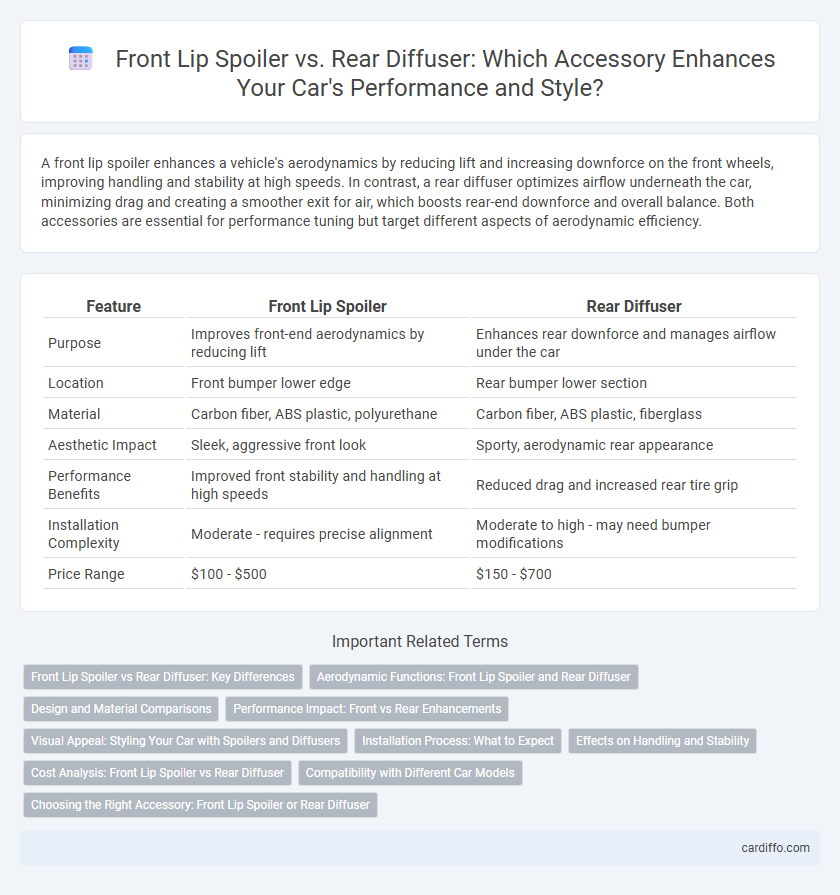A front lip spoiler enhances a vehicle's aerodynamics by reducing lift and increasing downforce on the front wheels, improving handling and stability at high speeds. In contrast, a rear diffuser optimizes airflow underneath the car, minimizing drag and creating a smoother exit for air, which boosts rear-end downforce and overall balance. Both accessories are essential for performance tuning but target different aspects of aerodynamic efficiency.
Table of Comparison
| Feature | Front Lip Spoiler | Rear Diffuser |
|---|---|---|
| Purpose | Improves front-end aerodynamics by reducing lift | Enhances rear downforce and manages airflow under the car |
| Location | Front bumper lower edge | Rear bumper lower section |
| Material | Carbon fiber, ABS plastic, polyurethane | Carbon fiber, ABS plastic, fiberglass |
| Aesthetic Impact | Sleek, aggressive front look | Sporty, aerodynamic rear appearance |
| Performance Benefits | Improved front stability and handling at high speeds | Reduced drag and increased rear tire grip |
| Installation Complexity | Moderate - requires precise alignment | Moderate to high - may need bumper modifications |
| Price Range | $100 - $500 | $150 - $700 |
Front Lip Spoiler vs Rear Diffuser: Key Differences
Front lip spoilers enhance aerodynamic efficiency by reducing front-end lift and increasing downforce, improving stability at high speeds. Rear diffusers manage airflow exiting from underneath the vehicle, reducing drag and enhancing rear downforce for better traction. Both components serve distinct purposes in vehicle aerodynamics, with front lip spoilers focusing on frontal balance and rear diffusers optimizing rear airflow dynamics.
Aerodynamic Functions: Front Lip Spoiler and Rear Diffuser
Front lip spoilers enhance aerodynamic performance by redirecting airflow to reduce front-end lift and increase downforce, improving vehicle stability at high speeds. Rear diffusers manage underbody airflow, accelerating air exit and decreasing turbulence, which lowers drag and enhances rear traction. Both components work synergistically to optimize overall vehicle aerodynamics, balancing lift and drag forces for improved handling and efficiency.
Design and Material Comparisons
Front lip spoilers often feature aerodynamic designs made from durable materials like polyurethane or carbon fiber to enhance airflow and reduce front-end lift. Rear diffusers typically utilize lightweight composites such as ABS plastic or carbon fiber, designed to optimize underbody airflow and increase downforce for improved stability. Both accessories prioritize high-strength materials for durability but differ in placement-driven design focus, with front lips targeting drag reduction and rear diffusers enhancing rear traction.
Performance Impact: Front vs Rear Enhancements
Front lip spoilers improve aerodynamic efficiency by increasing downforce at the front, enhancing steering responsiveness and stability during cornering. Rear diffusers optimize airflow underneath the vehicle, reducing drag and increasing rear downforce, which boosts high-speed traction and overall handling. Balancing front and rear aerodynamic components is crucial for maximizing performance gains and maintaining vehicle stability at various speeds.
Visual Appeal: Styling Your Car with Spoilers and Diffusers
Front lip spoilers enhance a car's aggressive stance by lowering the visual profile and emphasizing the vehicle's width, creating a sportier look. Rear diffusers add dynamic texture and depth to the rear bumper, accentuating aerodynamic features and generating a performance-oriented aesthetic. Combining both elements balances the front and rear styling, transforming the car with cohesive visual appeal and improved street presence.
Installation Process: What to Expect
Installing a front lip spoiler typically involves aligning the spoiler with the vehicle's bumper, drilling precise holes for mounting brackets, and securing with screws or adhesive tape designed for automotive use. Rear diffuser installation requires careful positioning under the rear bumper, often necessitating removal of existing bumper components, and fastening with bolts to ensure stability at high speeds. Both processes demand attention to fitment accuracy and may vary based on vehicle make and model, influencing installation time and complexity.
Effects on Handling and Stability
A front lip spoiler enhances handling by increasing front-end downforce, improving grip and steering response during high-speed cornering. Rear diffusers optimize airflow under the car, reducing drag and generating rear downforce that stabilizes the vehicle at higher speeds. Together, these aerodynamic accessories improve overall stability and balance by distributing downforce effectively across the chassis.
Cost Analysis: Front Lip Spoiler vs Rear Diffuser
Front lip spoilers generally cost between $100 and $300, making them a more budget-friendly option compared to rear diffusers, which range from $200 to $600 due to their complex design and installation requirements. The material quality, often polyurethane or carbon fiber, significantly influences price variations for both accessories. Labor costs for fitting rear diffusers tend to be higher, reflecting the additional time and expertise needed compared to the simpler installation of front lip spoilers.
Compatibility with Different Car Models
Front lip spoilers and rear diffusers offer distinct aerodynamic benefits, with compatibility varying significantly based on car make, model, and year. Front lip spoilers typically fit sedans and sports cars with defined front bumpers, enhancing downforce and aesthetic appeal, whereas rear diffusers are more common on performance vehicles to reduce drag and improve airflow under the car. Ensuring proper fitment requires checking specific product designs against vehicle dimensions, mounting points, and OEM specifications for optimal function and seamless integration.
Choosing the Right Accessory: Front Lip Spoiler or Rear Diffuser
Choosing between a front lip spoiler and a rear diffuser hinges on your vehicle's aerodynamic needs and style preferences. A front lip spoiler enhances front-end downforce, improving high-speed stability and cornering grip, ideal for performance-focused drivers seeking aggressive aesthetics. In contrast, a rear diffuser manages airflow under the car to reduce drag and increase rear downforce, benefiting rear traction and fuel efficiency on sporty or track-oriented vehicles.
Front lip spoiler vs Rear diffuser Infographic

 cardiffo.com
cardiffo.com